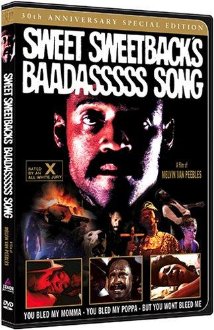Considered the first blaxploitation film, Sweet Sweetback’s Baadasssss Song features Melvin Van Peebles (who also directed, wrote, produced, edited and did music for the film) as Sweetback, a Los Angeles-area “male prostitute”/”sex performer” (who only has relations with females). He agrees to be taken in to a police station as a suspect just to make a couple cops look good (because they are tolerant towards the cathouse he lives in). On the way, they pick up a Black Panther and start beating him senseless. Sweetback bludgeons and stabs the two cops with his handcuffs (one end is open) and the bulk of the film has him on the run. Can he make it to Mexico before he’s caught?
Sweet Sweetback’s Baadasssss Song has a lot of historical significance. It is an early independent film in what’s considered the current “modern” style, it is one of the earliest mostly black films of its era (there were all black films earlier, such as Oscar Micheaux’s work, but they disappeared for awhile), it was controversial (it initially earned an X rating (later changed to an R) and touted that fact proudly as a tagline), it was made for $150 thousand but grossed $15 million, and most importantly perhaps for some film lovers, it is credited with starting the blaxploitation craze in the 1970s. It is worth watching for students of film on those merits alone.
But none of those facts alone make it a good film, and none affect my rating. In terms of quality, Sweet Sweetback’s Baadasssss Song gets my vaunted 5 out of 10 rating, which is usually reserved for “so bad they’re good” films. Although it is loaded with flaws, as one might expect from a low budget film from the era shot guerilla-style on the streets of Los Angeles, it is a hoot to watch. On the weirdness scale, it definitely earns a 10.
Sweet Sweetback’s Baadasssss Song is firmly mired in the psychedelic era. Peebles gives us frequent shots with negative or false colors near the beginning of the film. More frequently, he directs scenes so they have various “altered reality” allusions–time stretching, repeating, stopping and stuttering, bizarre actions and reactions from various characters, rambling nonsense, and so on–which for the viewer approximate the perception of someone who is wasted almost to the point of passing out. These scenes often play like some kind of avant-garde performance art, and are as much a focus of the film as any of the usually cited “political” messages rooted in racially oriented turmoil and disparity. Perhaps the intended theme was that race relations, and the urban reality of blacks to that point were as bizarre as acid trips, some good, some bad.
The music is equally bizarre (which I love), with a recurrent jazz/funk piece with an almost atonal saxophone melody being the unifier. Some of the vocal music is a veritable Greek chorus, narrating action and emotions, providing critiques and so on. Peebles also frequently layers musical tracks, so two or more can be playing at once for a minute or two.
The film is also notable and admirable for its abundance of almost graphic sex scenes and gratuitous nudity. The opening scene is particularly groundbreaking and laudable. Throughout the film, Sweetback is an unstoppable stud, with almost any woman he desires dropping her drawers for him, even towards the end of the film, despite the fact that he has an oozing, infected sore running up the side of his body, not to mention that he’s filthy, and he’s been drinking mud and eating raw lizards. The ladies still find him hot enough to give him a poke in the bushes. We need much more of this kind of material in contemporary films.
At one point, Peebles and/or director of photography Robert Maxwell appear to have hit the streets of Los Angeles, filming people at random after they asked them if they’ve seen Sweetback (the character). These shots are inserted into the extended chase scene near the end of the film (2/3 to 3/4 of the film is actually an extended chase scene). The effect is a lot of fun to watch–definitely guerilla film-making at its finest.
But the problems with the film are legion. Maxwell’s camera frequently goes in and out of focus (being generous, we could interpret it with psychedelic intent, but I’m skeptical). Night scenes (which are thankfully avoided for the most part) tend to be seas of blackness where a viewer can only occasionally make out enough of an image to piece together the scene in their mind. The sound is awful–I couldn’t make out about half of the dialogue (at one point I thought “this is more like watching a silent film”), and it doesn’t help that some characters “jive talk”; if ever a film needed subtitles, it’s this one. The camera occasionally has a spot, a hair, or some other gunk on the lens. There isn’t much to the story; after awhile, it starts to play more like an odd music video. A lot of shots–scenery, cityscapes, etc.–look like they may have been randomly taken by Peebles with his home camera with the hopes of one day using them in a film.
Still, for fans of weirdness and “so bad they’re good” films, not to mention any blaxploitation fan with his or her weight in barbecued ribs, Sweet Sweetback’s Baadasssss Song is a must see. Make sure you also check out How to Get the Man’s Foot Outta Your Ass (aka Baadasssss!), Peebles’ son Mario’s 2003 film about Sweet Sweetback’s Baadasssss Song.

